In a futuristic future exhibition, the research and cultural association 'Dresden-Concept' presented its visions of the future in an open-air stele show. The author explores the question of how sensor technology will develop and be used in the future in conjunction with rapid communication and data processing using artificial intelligence in neural networks (which function similarly to the human brain).
With the question 'What does our future look like?' in mind, scientists from the Dresden-Concept network of research and cultural institutions created an interesting futuristic open-air exhibition in October. "Climate change, demographic change, pandemics and megacities are just some of the major challenges facing our society," said the curators. In the stele show, they presented current cooperative research projects and innovations by Dresden scientists in the research fields of digitalization, mobility, materials of the future and solutions for healthy living, cultural assets, climate and water.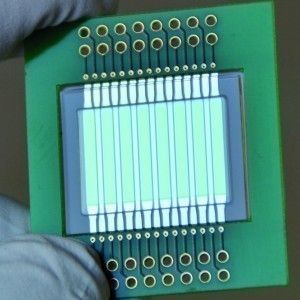 Optoplasmonic sensor for milk analysis
Optoplasmonic sensor for milk analysis
Sniffing like a dog
At the moment, we are particularly interested in how the pandemic is progressing. The key issues are the tests. Corona sniffer dogs are being used at Helsinki and Dubai airports. They are supposed to sniff out infected people at the airport. Experts say that specially trained sniffer dogs can smell the virus with almost 100% certainty, even before people show symptoms. It is known that trained dogs not only follow the scent of people, explosives or drugs, but can also sniff out and detect various lung or bowel cancers caused by bacteria or cancer cells at an early stage. Even untrained dogs can detect the onset of hypoglycaemia in their master and warn him with unusual reactions. They identify volatile organic compounds such as acetone in the air they breathe or in excreted urine. In a pilot study by Finnish researchers, dogs were able to distinguish who was infected with coronavirus by the smell of their urine and were just as accurate as in classic Covid-19 tests; in some cases, they even performed better. At the University of Veterinary Medicine Hanover, research is being conducted together with the German Armed Forces Dog School into whether assistance dogs could be trained to sniff out the onset of a coronavirus infection before serious symptoms appear.
Scientists around the world have long been working on tapping into dogs' keen sense of smell for humans and reproducing it using sensor technology. Molecular biologists from the Max Planck Institute of Molecular Cell Biology and Genetics in Dresden have developed a method to analyze the microscopically small rigid cell antennae (cilia) that are important for our sensory perception, the institute announced in October.
At an 'Intelligent Noses' conference in Dresden, 25 scientists from Germany, Switzerland, France, Great Britain, Israel, Italy and the USA discussed the extent to which it is possible to use technical means to determine whether a person has Covid-19 disease in the air they exhale. Researchers at TU Dresden want to use adaptive chemical sensor technology (olfactory perceptronics) to develop artificial sniffer noses that can compete with the sensitive sense of smell of a sniffer dog, explained project coordinator Prof. Gianaurelio Cuniberti from the Chair of Materials Management and Nanotechnology. He emphasized: "The visionary concept of an artificial nose brings together physiological and psychological aspects of perception with the latest developments in electronics." Artificial noses already exist, but a breakthrough in perceptronics is to be achieved in a concerted effort by science, technology and medicine, building on the latest advances in nanotechnology and artificial intelligence. This will make it possible in future to build particularly inexpensive, small and fast-judging artificial noses the size of computer chips. It would be conceivable to integrate such nose chips into smartphones. In future, anyone could use their cell phone to detect spoiled food, bad air in the office or virus-infested buses. They could also help people who have temporarily or permanently lost their sense of smell due to an illness. TU Dresden and the Saxon Ministry of Economic Affairs announced in August that the researchers are working on the development of a bioelectronic rapid detection sensor for SARS-CoV2 viruses at an early stage.
Using a new generation of organic light-emitting diodes (OLEDs), Fraunhofer researchers in Dresden want to combine organic electronics and organic sensor technology to create modules that quickly detect bacterial contamination in dairy products. In the MOLOKO project funded by the European Commission, researchers at the Fraunhofer FEP are working with partners to develop an optoplasmonic sensor that will enable rapid on-site analysis of food quality and safety parameters. The early warning system should help to drastically reduce costs, time and product waste in the future and optimize production in the supply chain. A microfluidic chip was developed for the complete system by Fraunhofer ENAS, an organic photodetector by Fraunhofer FEP and an organic light-emitting transistor (OLET) and the sensor, a nanostructured plasmophotonic grating, by the Italian CNR-ISMN and Plasmore Srl. Dr. Michael Törker explained the principle: the antibody-coated grating is irradiated with light generated by the transistor and the photodetector measures the minimally altered refractive index (surface plasmon resonance) caused by the adhering molecules of the substance under investigation. "The special feature of our chip is its reusability - we detach the target molecules from the immobilized antibodies using a regeneration buffer so that the latter can be reused." Using transparent and conductive tin and aluminum-zinc oxide, researchers at Fraunhofer FEP, together with the DLR Institute of High Frequency Technology and Fraunhofer ILT, integrated radar antennas, sensors and additional electronics into the glass of car headlights. This allows more sensors for automated driving to be integrated into the car than was previously possible in the radiator grille, making the car more autonomous.
In 2018, Dr. Bernhard Siegmund was awarded the Innovation Prize of the Industrieclub Sachsen e. V. for the innovative sensors for near-infrared radiation (NIR) for the contactless determination of chemical compositions developed as part of his dissertation at the TU Dresden Institute of Applied Physics and constructed from organic microsystems. The start-up Senorics GmbH is a spin-off of TU Dresden that develops mini spectrometers made of organic electronics for the food industry and medical technology. These tiny devices irradiate food, drinks or clothing with light from the NIR range and then use the spectrum of the reflected rays to determine the chemical composition of a T-shirt, a type of beer or an apple, for example. Until now, comparable NIR measurements could only be carried out using expensive, large and sensitive spectrometers in the laboratory, explained Hannah Szynal. The monolithic sensor developed, on the other hand, is about the size of a postage stamp and is also quite robust against external influences, as it does not require any moving parts. The technology can be miniaturized to such an extent that it can be integrated into smartphones. The company was awarded the 2019 Innovation Prize for a sensor used in beer brewing. This September, it was announced that Senorics had signed a contract with the Chinese major household appliance group Haier Cosmoplat to equip washing machines and refrigerators with its organic infrared mini-spectrometers. The company wants to find out which household appliances are suitable for these remote analysis chips and then launch the technology on the market in China and Europe. Chinese consumers are known to try out and adopt the latest technologies very quickly if they see added value for their everyday lives.
Due to the strong international demand for its precision thermal imaging cameras, infrared sensors for gas analysis and other detection systems, InfraTec GmbH Infrarotsensorik und Messtechnik in Dresden is investing again, having just expanded its optoelectronics factory. A further million-euro investment in sensor production is planned in order to increase production capacity by a third. The company also uses the particularly precise infrared sensors developed and produced in its clean rooms to manufacture high-tech cameras that are used in drones or as corona fever measuring devices, to monitor solar thermal systems and nuclear fusion test reactors, as night vision devices or for thermography devices to record heating energy losses in buildings.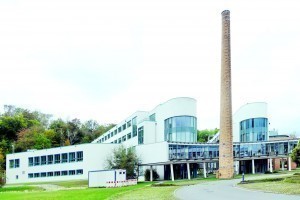 Infratec GmbH Dresden
Infratec GmbH Dresden
A team led by Dr. Richard Gloaguen and Dr. Axel Renno is developing a new waste analysis machine to reduce the global mountains of electronic waste, the Helmholtz Institute for Resource Technology Freiberg has announced. Using adaptive multi-sensor camera systems, artificial intelligence and numerous sensors, the machine is able to recognize metals, plastics, ceramics and composite materials in waste streams so that other machines can later break down this flood of waste automatically. Initial successes have already been achieved in the laboratory and a demonstrator plant will be built for practical testing by mid-2021.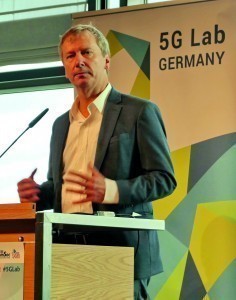 Prof. Gerhard Fettweis TU Dresden
Prof. Gerhard Fettweis TU Dresden
The possible construction of sensors based on nanotubes and nanowires has long been the subject of research. The change in conductivity on the nanoparticles is used for gas analyses. For liquid analysis, the gate surface of CNT FETs is coated with a semi-permeable layer that is only permeable to ions of a very specific type. When the FET is immersed in the solution, these ions migrate through to the gate and shift its electrical potential. The analysis of biological substances is also being investigated. Research is also being carried out on lab-on-chips, which allow many parameters to be measured in parallel. Researchers at the Karlsruhe Institute of Technology have developed a low-cost odor sensor based on nanowires. This Karlsruhe micronase (Kamina) is intended to be suitable for everyday use and sniff out potential dangers such as smouldering cables or spoiled food earlier than a person. It consists of a sensor chip on which nanowires made of tin dioxide are attached to many individual sensors. The chip calculates specific signal patterns via the change in resistance in the individual sensors, which in turn depends on the molecules in the ambient air. The resistances are characteristic and recognizable. If the pattern has been taught into the chip beforehand, the odour sensor can recognize it within seconds. Could it then also smell Covid-19 diseases?
Tactile response like humans and animals
The fastest processing of data and lightning-fast transmission to humans and machines is essential for such highly developed sensor technology. The start-up Hyperspecs from Berlin is part of the premiere class for a new Samsung incubator program in Dresden. Founder Diwaker Jha and his colleagues are developing a kind of network of all-seeing eyes that anticipates accidents in industrial plants and warns workers of toxic gases in leaking pipes or tripping hazards. To achieve this, Hyperspecs combines a large number of digital cameras with artificial intelligence and networks all of this using the new 5th generation mobile communications standard, as this can react very quickly (tactilely) to sensor inputs and is also capable of managing numerous devices in parallel. In the incubator system, Hyperspecs also receives technological support for its 5G concept from the 5G-Lab Germany at TU Dresden, one of Germany's leading research institutions for new generations of mobile communications.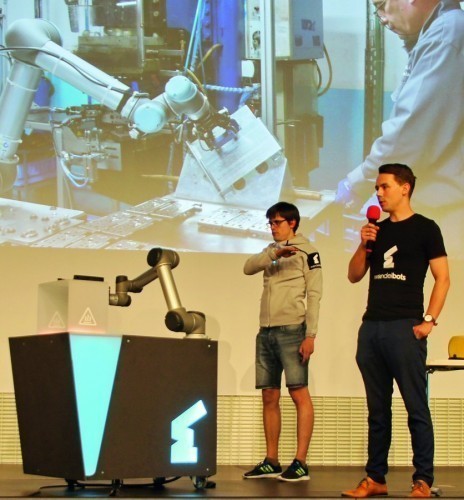 Wandelbots' teaching technology also enables non-professionals to teach a robot and collaborate with their human colleagues. Demonstrated at the 13th Silicon Saxony Day 2018 (PLUS 7/2018) by Christian Piechnick and Jan Falkenberg (here still with sensor jacket, a pen-like handheld device 'Trace-Pen' has been on the market since October)
Wandelbots' teaching technology also enables non-professionals to teach a robot and collaborate with their human colleagues. Demonstrated at the 13th Silicon Saxony Day 2018 (PLUS 7/2018) by Christian Piechnick and Jan Falkenberg (here still with sensor jacket, a pen-like handheld device 'Trace-Pen' has been on the market since October)
At the digital Fraunhofer trade fair 'Fraunhofer Solution Days' at the end of October, Fraunhofer IPMS was represented by the Fraunhofer Project Center for Microelectronic and Optical Systems for Biomedicine and the Research Fab Microelectronics Germany with the topics of healthcare and mobility. The IPMS presented product-related technologies for sensor nodes in the LF to UHF range with RFID circuits for easy integration of various analog and digital sensors as well as the application of the NED inchworm actuator for mobile microscopy or respiratory gas analysis using ion mobility spectrometry. The latter and a spirometric ultrasound-based breath analysis using a MEMS-based ultrasound system are being developed as part of the M3 Infect project. This Fraunhofer project is creating a modular system for the mobile recording of relevant biosignals from patients who have not previously received intensive care in order to detect acute exacerbations of disease.
Researchers at TU Dresden have developed innovative modulators for 5G that react ten times faster than the most modern devices to date. "We have built a 5G modem that reduces latency to one millisecond," said Professor Gerhard Fettweis from the Vodafone Chair of Mobile Communication Systems and one of the coordinators of the interdisciplinary 5G Lab Germany at TU Dresden. The plan is to found a company that will bring this innovative technology to market maturity and commercialize it. Together with practice partners, researchers from TU Dresden and Fraunhofer are setting up test fields in Lusatia, where 5G-networked and highly automated agriculture will be tested in farming practice. At the same time, this company is to further develop the ultra-fast 5G modems. The new one-millisecond technology enables ultra-reliable and low-latency communication (URLLC) and is set to expand the 5G standard from 2022 as an intermediate stage to 6G mobile communications, which is being worked on worldwide, including in Dresden. The 'Center of Excellence for Tactile Internet' at TU Dresden has spun off the company 'Campus Genius', which now develops, sells and supports campus network cores and containers for Industry 4.0. Originally designed for demonstration purposes, their mobile 5G transmission stations can be transported to any location using a special car trailer, where they can be used to test the latest automation and robotics solutions for longer periods of time. At a bakery in Görlitz, which was unable to find apprentices to bake bread rolls early in the morning, such a mobile 5G network was set up and robots were trained as bread roll bakers using training technology from Wandelbots GmbH. If required, they can also work side by side with human colleagues. "A robot like this can place 2,000 to 3,000 dough pieces on the trays per shift and it is never late for work or disappears for a smoke break."
Dresden-based Metirionic GmbH (co-founder Prof. Bernd Junghans) develops sophisticated positioning technology. The software measures the distance and angle between two or more chips that transmit according to the Zigbee or Bluetooth standard. This enables very precise positioning. In contrast to other technologies such as GPS, the technology also works inside buildings and through many walls with an accuracy of 20 to 50 cm and long ranges of up to 100 meters (up to 5 km in open terrain). The focus is on the transfer to the next Bluetooth generation (integration in smartphones) or other radio standards (UWB). Consideration is being given to transforming the GmbH into an AG.
Thinking like a human
Scientists at TU Dresden and the Helmholtz-Zentrum Dresden-Rossendorf (HZDR) have succeeded for the first time in imitating the functioning of the brain's neurons using semiconductor materials. They have published their research results in the journal Nature Electronics. One approach is based on the brain and combines data processing with data storage in an artificial neuron. Prof. Gianaurelio Cuniberti (Professor of Materials Science and Nanotechnology at TU Dresden), his Dresden colleague Prof. Ronald Tetzlaff (Fundamentals of Electrical Engineering) and Prof. Leon Chua from the University of California, who had already postulated similar components in the early 1970s, are regarded as the intellectual fathers of the neurotransistor. Prof. Cuniberti and his team are aiming less at conventional problems, as computers based on their chip processors are less precise and would rather estimate than calculate mathematical calculations, but they are more intelligent. Thanks to their so-called plasticity, which is similar to that of the human brain, such 'neuromorphic' computers built from tiny nanowire transistors can adapt to changing tasks during operation and also solve problems for which they were not originally programmed, the team has demonstrated. Neuromorphic computers are needed, for example, for artificial intelligence, in self-driving cars, in image recognition and for other analysis tasks for which conventional computers consume too much time and energy.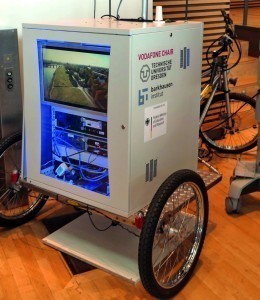 5G campus containerdemonstrator at the 5G Summit Oct. 2019
5G campus containerdemonstrator at the 5G Summit Oct. 2019
One of the HZDR's research topics is quantum technology. Quantum computing and communication are considered to be important key technologies for the coming decades. This is because computers based on quantum mechanics can solve many encryptions that were previously considered unsolvable. Quantum communication is considered tap-proof because it entangles photons over distances in such a way that the sender and receiver can immediately see if a spy is hacking into the line. The physicists have constructed a new type of source for precisely dosed light particles (photons) for this purpose. Although there are already photon sources for quantum communication, they are usually made of expensive diamonds and have difficulty using normal fiber optic networks. Infrared light quanta, on the other hand, also travel through conventional optical fibers. And the sources for this are created using proven methods and materials from microelectronics. By bombarding silicon with carbon atoms, G centers were created, two neighboring carbon atoms that together with a silicon atom form a kind of artificial atom. Under laser bombardment, these centers then emit light particle currents with a wavelength suitable for glass fibers. So far, however, the system only works at extremely low temperatures.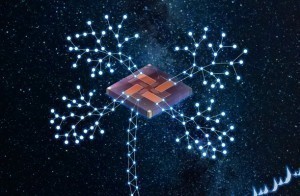 Neurotransistor: from silicon chip to neuromorphic architecture (source HZDR)
Neurotransistor: from silicon chip to neuromorphic architecture (source HZDR)
A quantum communication research center was set up at the Fraunhofer EAS in Dresden with funding from the state government in order to develop capable devices for this technology and to transfer the results of basic research into practical applications. A local test track is being set up for this purpose. "Saxony can benefit considerably from this as a business and research location for microelectronics," emphasized State Chancellery Head Oliver Schenk. "There are great opportunities, particularly in the development of the necessary electronic components." A new exhibition and an experimental portal on quantum technology in the 'Technische Sammlungen Dresden' will give visitors an impression of outstanding research projects at the city's university and non-university research institutions, said museum director Roland Schwarz.
To connect human brain cells and nerves with a computer, an international team of neuroscientists from the universities of Sheffield, St. Petersburg and Dresden has used the possibilities of 3D printing to bring the technology for manufacturing neural implants one step closer to reality. The proof-of-concept technology has shown in the study that it also fits well on the surface of a brain, spinal cord, peripheral nerves and muscles, thus opening up new possibilities for neurological diseases. Such organic sensor implants could be used to warn epileptics of impending seizures.
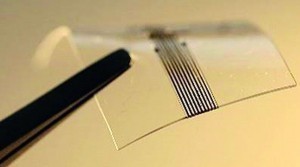 Nerve implant in organic assembly and connection technology (Source TU Dresden)
Nerve implant in organic assembly and connection technology (Source TU Dresden)
About the person
Dr. Rolf Biedorf has been writing for Leuze Verlag since 1994 and has been reporting on current events in the Saxon microelectronics scene in PLUS for 10 years. After studying chemistry, he worked in the electronics industry and, above all, at the TU Dresden in research and teaching in the fields of layer and packaging technologies in electronics.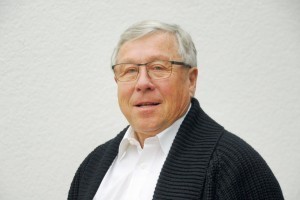 Dr. Rolf Biedorf
Dr. Rolf Biedorf
Sources:
Communications from the research institutes
News portal Oiger, computer-oiger.de


